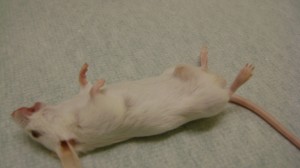WHO OVERSEES THEIR WELFARE?
– Canadian Council on Animal Care (CCAC)
Ideology
- CACC’s animal care guidelines: “Any actual or potential pain, distress, or discomfort should be minimized or alleviated by choosing the earlier endpoint that is compatible with the scientific objectives of the research”
- How?
– Recording on observational checklists
– Assigning objective values on animal condition
– Looking out for significant indicators of negative experience and physical deterioration
– Meeting scientific demands for an objectively measured and significant endpoint, and defining information/data required for the experiment
– Animal should be handled daily to evaluate the changes in body weight, external physical appearance, measurable clinical signs, changes in unprovoked behaviour, and behaviour responses to external stimuli
Reality
- Technicians often just peer into each cage briefly to check water and food availability during daily health check
- Only open cages and handle animals with cages with mice already with health issues and have their cages flagged or when mice with new abnormalities visible
- Why? limitation to staff number, excess number of cages and animals, assigned work hours, inadequate training
Resulting Welfare Problem
- Mice are small prey mammals that conceal their discomfort from sickness and injury well to prevent predation, so quick health checks on each cage often resulted in neglect to minor but significant changes in animals’ health
- When a mouse’s is showing observable negative signs, it has usually endured days of suffering and pain from deteriorating health and cannot recover even with treatment
- Delayed discover of severe conditions:
E.g. Dehydrated and/or starving mice that have lost >10% body weight because of
malocclusion, wounded mice with deep raw lesions from dermatitis and/or fights,
or mice that have been dead for more than 48 hours
Possible Improvements
- Considering a staff increase: so each staff member can be assigned to check fewer cages within their set work hours, and each technician can carefully examine each animal more through longer observation time and individual handling to minimize possibility of neglecting animals that are in pain, suffering, or dead.



